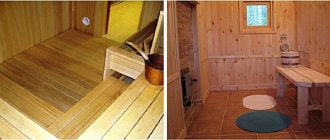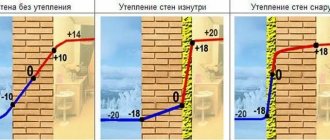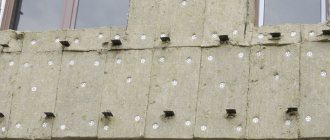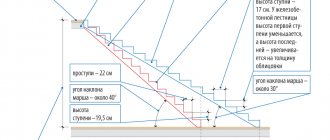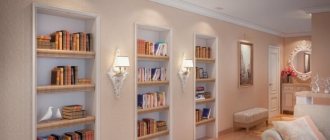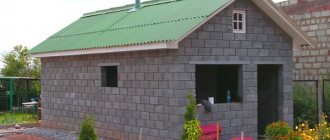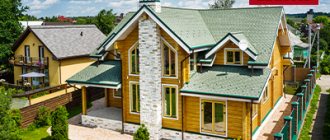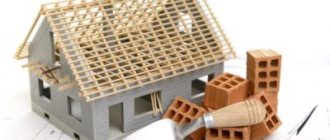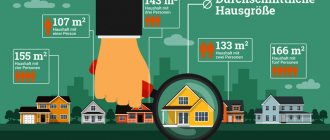Real estate
00:00, 02.12.2020 12 Plot: House in focus
Advantages and disadvantages of the four most popular materials
Photo: Irina Plotnikova
The variety of modern construction technologies can cause panic in the future homeowner: the choice is large, some types of materials are close to each other in cost, but they all have different features. In this article we do not set out to understand all the nuances of materials science, but a start will be made. Today we will outline the main range of questions that you need to ask yourself when choosing a wall material, and we will list the main features of some of the technologies that are the most popular in our latitudes. And in subsequent articles we will analyze each technology in more detail.
Video description
For more information on comparing different technologies, watch the following video:
Table 1. Volume of repair work after 30 years Source bako.ru
Table 2. Comparison of the durability of buildings depending on the main building material Source bako.ru
Now let’s move on to describing the features of each type of building material separately.
Sand-lime brick - affordable price, convenient sizes, high quality
It has a gray-white hue and is made from a mixture of sand, additives and lime. This type of brick is available in two types: with and without internal cavities.
The strength of sand-lime and ceramic bricks is determined by the assigned grade. Manufacturers mark bricks with the letter symbol M and a serial number. The higher this number, the greater the load it can withstand.
For the construction of walls of a two-story house, it is recommended to use grades M100 and M125. The ground floor and foundation are laid out with grades no lower than M150.
Construction of a house for permanent residence made of brick
Buildings made of brick are the most massive structures. They perfectly resist the effects of all kinds of natural factors and, at the same time, have an attractive appearance. However, in order to build your own house from the most popular material at first glance - brick, you will have to incur significant financial costs. But the durability of such a house will be significantly higher. If a good-quality frame house “lives” for about 60-70 years, then a house made of good brick will last more than 100 years. However, it is important to note that brick also comes in different qualities. Therefore, if you decide to build with brick, take special time to study the characteristics of the material in order to wisely choose a quality one. Pay special attention to the frost resistance of the brick - how many cycles can it withstand (30, 50, 100?).
Building a brick house Source sk-mera.ru
The main advantages of a brick house are the high strength of the material. And in terms of its load-bearing capacity characteristics, a wall erected from this type of building materials is almost as good as concrete. Such characteristics are ideal for both low-rise suburban construction and the construction of multi-storey buildings. In addition, a house made of brick will not burn, rot or shrink.
Only, in terms of energy efficiency, walls made of ceramic or sand-lime bricks lag significantly behind other building materials. In order to ensure sufficient energy efficiency for a private home, a brick wall must have a minimum thickness of 120 cm. It becomes clear that no one will build a “bunker” with such walls for permanent year-round living, so today brick is increasingly used as a facing material.
Another important disadvantage of building a house made of bricks is the high cost of the material, so it is important to correctly calculate your financial capabilities, otherwise construction may take a very long time.
Summarizing all of the above, we can say that the main advantages of brick as a building material are:
- the possibility of long-term operation of the built house;
- high frost resistance;
- precise geometry of products;
- good combination with any type of masonry mortar;
- high strength;
- aesthetic appearance.
However, brick has many disadvantages :
- Low moisture resistance of some types of material. For example, sand-lime brick strongly absorbs water; this can be clearly seen when it takes on a dark tint during rain. This quality greatly affects the humidity indoors. In this regard, sand-lime brick is not used for laying basements and basements; sand-lime brick should not be used when building a house in regions with high air humidity. To prevent moisture from accumulating in a brick house, you need to properly prepare the walls. And these are additional costs that are often overlooked.
- High thermal conductivity. To achieve positive characteristics, it is necessary to resort to additional costs for thermal insulation of walls or thickening them.
- High product weight. The brick has a large mass, which makes the structure heavier and creates an even greater load on the foundation. To solve this problem, it is necessary to build a stronger and more solid foundation, and this further increases construction costs.
- High cost of material. It is certainly more expensive than materials for frame construction. In addition, one should not lose sight of the cost of transportation costs, which amount to around 4% of the cost of the property. These are direct costs such as fuel, depreciation, oil, drivers and so on.
So, it turns out that brick, despite its tangible advantages, has significant disadvantages, so before making it the main material in the construction of a private house, you should clearly define your financial priorities, since your choice will depend on them.
See also: Catalog of house projects presented at the Low-Rise Country house exhibition.
Beautiful house made of timber Source comfortoria.ru
Ceramic block - durable and modern material
In Europe, when deciding what material to build a house from, they often choose ceramic block. It is environmentally friendly (consists of a baked mixture of clay with wood sawdust), and it can be built cheaply and quickly. A house like this will last for at least 150 years, and it can be made multi-story (the safety margin allows this). The surface of the ceramic block is corrugated on the sides, and there are pores inside. The individual elements are joined using a tongue-and-groove connection.
Ceramic blocks of various sizes.
Dimensions and characteristics of ceramic blocks
The sizes of ceramic blocks vary, but their height is standard, equal to brickwork. This is convenient - you can build according to the design of a brick house. A block measuring 50 x 24.8 x 23.8 cm weighs 25 kg, and the volume is equal to 15 bricks of 3.3 kg each. It’s easier and faster to lay one such slab, and you’ll need less mortar. The width of the blocks is 23, 24 and 25 cm. Their length (which determines the thickness of our walls) can be from 25 to 51 cm. A tongue-and-groove lock is located on this side.
To lay a load-bearing wall, blocks with a length of 30 cm are taken. And if you make walls 38 cm thick or more, you won’t even have to insulate them. After all, porous blocks have low thermal conductivity - from 0.14 to 0.29 watts per square meter per degree Celsius. Thicker blocks (38, 44 and 50 cm long) are marked as M100. If thin but reliable walls are planned, then you can take M150 brand blocks. The ceramic block can withstand up to 50 freezing and defrosting cycles. This matches the F50 brand.
Advantages and disadvantages of ceramic blocks
| Advantages of ceramic blocks + | Disadvantages of ceramic blocks - |
| Low weight coupled with high strength allows the construction of even multi-story buildings. And quickly and without unnecessary labor costs. | High price - this material for the walls of the house belongs to the elite group. |
| The mortar is used more economically than for brickwork - there is no need to use it in vertical joints. | It is difficult to find a good craftsman to build walls, since the material is quite new. |
| Frost resistance at a high level. | Ceramic blocks are very fragile, so they must be transported and stored very carefully. |
| The material can withstand fire for at least 4 hours. | |
| Thanks to its porosity, the ceramic block perfectly absorbs noise and also retains heat. | |
| The walls of these blocks “breathe”, regulating humidity and creating an excellent microclimate. | |
| Such a house can last up to 150 years, and the thermal characteristics of the walls do not deteriorate. |
Construction of a house from concrete blocks
Today, among building materials, brick is significantly reducing its position, giving way to modern building blocks.
Affordable price is the main reason determining the choice of blocks. At the same time, building a house for permanent residence from blocks is not only cheaper, but also much faster, since such large-sized material in quantity can replace from 4 to 14 ordinary bricks.
Today the building materials market offers the following types of blocks:
- gas blocks;
- foam blocks;
- cinder blocks;
- expanded clay concrete blocks;
- wood concrete;
- shell rock blocks;
- ceramic blocks.
Let's take a closer look at each type.
Gas and foam blocks
Gas and foam blocks have the same technical characteristics and are excellent for the construction of low-rise buildings. They have a more precise dimensional geometry, which affects the thickness of masonry joints, the consumption of expensive masonry mortar, the thermal conductivity of the wall taking into account the masonry mortar, and the labor intensity of masonry. For comparison: the thickness of the masonry for aerated concrete blocks is 1-1.5 mm, and if we talk about ceramic bricks, the thickness of the masonry will range from 10 to 15 mm.
Their only difference is the internal structure of the material.
Aerated blocks are made from a homogeneous mixture of sand, cement and lime with the addition of a special powder - a gas-forming agent, in order to achieve small through channels inside the block. When choosing such a material, it is better to give preference to blocks made using autoclave technology, as they have better strength characteristics.
Construction of a house from aerated blocks Source dizajio.com.ua
Foam blocks, on the contrary, have closed pores inside the material. Such a structure is achieved during production by adding special substances - foaming agents - to the concrete solution. It is worth noting that such production makes it possible to increase the quality of foam blocks, creating additional energy-saving capabilities for the material and significantly reducing its weight. Also, unlike a gas block, whose open channels conduct moisture well, foam blocks do not need additional protection from moisture.
They produce blocks of various formats and thicknesses, which allows the developer to choose the optimal material for individual construction without extra costs for additional insulation. Good geometric data allows you to build houses with a complex structure.
Also, foam blocks and gas blocks do not require complex finishing; this can be done using putty or decorative plaster.
In addition to all the listed advantages, a significant argument in choosing this particular material for construction will be its low cost. The average price on the construction market for 1 m3 is about 3 thousand rubles.
All other building parameters being equal, a house frame made of aerated concrete blocks is cheaper than a house frame made of ceramic blocks. However, further construction operations neutralize this large initial difference.
Among the disadvantages of foam and gas blocks, the following characteristics of these materials can be identified:
- Fragility . Even the highest quality blocks are easily damaged during transportation or during the construction process. Therefore, they should be handled with extreme care.
- High water permeability (for gas blocks) . This requires the inclusion of additional work during construction in order to create conditions for the safety of structures inside and outside the building.
- Mandatory external and internal decoration of the house . When building a house from aerated concrete blocks, it is very important to pay special attention to the thermal efficiency of the walls of the building: the thermal resistance should not be less than 3 units. Do not skimp on wall thickness and materials. Otherwise, you will end up with a situation where the plaster falls off, cracks appear on the walls, and condensation accumulates on the walls inside the house, which leads to the development of foci of fungal infections.
- Presence of chemical elements in the composition.
- All technological operations are more complex . For example, laying communications in the natural cavities of the walls of a frame house will not cause any special difficulties. But when it comes to a stone or brick house, the volume and complexity of the work increases significantly.
Conclusion
Everyone is looking for the ideal wall material that would have high strength, good thermal insulation, environmental friendliness and low cost. Modern technologies make it possible to work wonders by combining many characteristics in a particular material. However, it is impossible to say unequivocally which block is better to build a house from; each has certain pros and cons, and the final choice depends on the budget, climatic features, and the quality of the site.
You can always use a block calculator if you need to calculate the amount of materials, their cost, find out the total cubic capacity and weight.
Construction of wooden houses for permanent residence
As for wood, there are two options for building materials:
- log;
- beam;
A house for permanent residence made of wood puts minimal load on the foundation, which allows you to save money already at the very first stage of construction.
An important point when choosing building materials is also considered to be that it is possible to build wooden houses regardless of the time of year and in any weather.
House made of timber
Modern timber will allow you to build a neat individual home in any style. It has good geometric parameters, rectangular or square cross-section and smooth, very even sides. Houses made of timber have minimal shrinkage, the manufacture of a log house does not require the use of special construction equipment, and the aesthetic properties of the material allow you to do without external and internal finishing, and thereby save on finishing work.
Construction of a house from timber Source strojka-doma.ru
The timber has a large number of advantages:
- environmental friendliness;
- aesthetics;
- efficiency of construction;
- high level of sound insulation and good thermal conductivity;
- strength and reliability of the structure;
- Possibility of installation at any time of the year;
- does not require the construction of a bulky, expensive foundation;
- does not require decorative finishing;
- positive, healing properties from wood.
However, timber also has disadvantages:
- The need for additional processing of the material . The main, common disadvantage of wood products is its susceptibility to moisture and insects. In addition, over time it has the ability to crack and rot, thereby losing its original aesthetic appearance, so the wood must be constantly treated with special substances.
- High fire hazard of the material. Any wood is highly flammable, and because of this requires additional protection by treating it with fire-retardant compounds.
- Requires additional costs for heat and waterproofing.
- Long-term shrinkage. Despite the slight shrinkage, a private house will sag within six months. In this case, during the shrinkage process, cracks may appear in the walls.
Ceramic brick - a classic of country house construction
Visual feature: red or orange color. It is made from fired clay and has impressive characteristics in terms of wear resistance, strength and durability.
This is one of the most highly environmentally friendly materials. Not afraid of high and low temperatures, as well as their changes. Does not deteriorate when exposed to sunlight, rain and snow.
There are two main types of bricks on the market: hollow and solid. For hollow - up to 50% voids are typical, for solid - this figure should not exceed 13%.
Bricks also differ in the shape of the voids and their number. As a rule, the more voids they have, the higher their thermal insulation qualities.
Construction of a frame house for permanent residence
Perhaps the most controversial thing is the frame technology of building houses for permanent residence. Let's try to understand the pros and cons. The frame of the building can be wooden or metal, but the wooden frame is still more popular.
The advantages of building walls using this technology are as follows:
- high thermal conductivity;
- the building is not subject to shrinkage;
- ease and speed of construction;
- ease of interior decoration;
- savings on foundation;
- environmental friendliness of materials.
An additional advantage of this technology is its low cost. Even if we compare the cost of a fully ready-to-move-in frame house with a brick facade and interior decoration, it will cost at least 40% less than its analogue made of aerated concrete or ceramic block.
Frame house under construction Source mebel-go.ru
Speaking about frame houses, it is important to note the disadvantages that, of course, exist. These include the following:
- high fire hazard;
- poor resistance to fungal infections;
- exposure to insects.
However, with a competent approach, these disadvantages can be leveled out through strict adherence to frame construction technologies.
Often a number of myths are attached to the disadvantages. Among such myths one can find, for example, statements about low sound insulation of premises and flabby interfloor ceilings.
Why are these myths?
The fact is that sound insulation can be low even in a brick house - and the problem here is rather erroneous calculations when designing walls and interfloor ceilings without taking into account the specifics of construction technology. Soundproofing characteristics depend on the multi-layer structure , and not on the thickness and type of wall material. And mineral wool, which is used in the construction of frame walls, is used not only for heat, but also for sound insulation. By the way, it is even used in recording studios.
As for interfloor ceilings, the problem is often in the desire to save on the non-obvious: we are talking about the rigidity of the floors. Flabby floors are often associated not with the lack of a proper engineering approach, but with the materials used in the construction, which is completely wrong. For example, beam sections of 150x50 mm will provide significant savings compared to beams with a section of 240x60 mm, but the stability of the floors will be significantly lower, which gives rise to the myth about the fragility of frame structures.
And, of course, like any other, a frame house requires the installation of a ventilation system. This is important both for comfortable living and for the safety of structures.
According to experts from the construction company BAKO, in all northern countries, including Russia, a double spatial wooden frame . It can consist of two evenly supporting structures or a main and additional frame.
Double wooden frame design: 1 and 2 - two frames that evenly provide the load-bearing capacity of the building. Source bako.ru
Design of a double wooden frame from the BAKO company: 1- main supporting frame, 2- additional frame. Source bako.ru
Detailed description of the components of a BAKO wall with a double frame Source bako.ru
What is the problem with single timber frame? On the thermogram of the room we see pronounced cold bridges along which heat is removed from the room (next photo on the left).
Thermogram of a wall with a single frame: thermal imaging of the corner of the room was taken in winter at low negative temperatures. On the right is a photo of the wall (we see the interior finishing materials), on the left is a photo of the same wall on a thermal imager (we see a pronounced frame - these are cold bridges). Source bako.ru
By using a double wooden frame of the house, we break the bridges of cold, keeping the house warm. Thus, we increase the energy efficiency of the house, reducing heating costs.
Comparison of frame types Source bako.ru
The double wooden frame of the house is designed for a load of 500 kg/m2 and guarantees the necessary spatial strength of the entire building structure. The pitch of the supporting frame of the external walls is from 400 to 660 mm. The interfloor ceiling with a total thickness of 0.4 m provides the necessary sound insulation and will not sag.
The choice of construction technology primarily depends on your wishes. You can build a better house using any technology . Not only technology is important, but also an integrated approach to construction, i.e. carrying out work from design to the final stage - delivery of a house ready for occupancy.
Be careful, unfortunately, turnkey offers from construction companies may mean completely different house configurations. For example, the cost of the foundation and wiring of utility systems may not be included, and some of the work will need to be completed so that the house can be lived in.
Remember, a “turnkey” offer means that the customer, as a result of the work from the builders, receives a house completely ready for occupancy. You get the key, move in and live.
Table. Comparison of different materials for building walls
| Material | Advantages | Flaws | Cost of materials and work $/M2 |
| Brick (thickness - 380 mm.) | Reliability; durability; environmental friendliness. | The need for insulation; labor intensity; heavy walls; you need a strong foundation. | 75 |
| Ceramic block (thickness - 380 mm.) | Reliability; durability; environmental friendliness; construction speed. | Fragility of the material; difficult to find a specialist. | 82 |
| Aerated concrete (thickness - 380 mm) | Speed of construction; durability; reliability; environmental friendliness; thermal insulation. | A solid foundation is needed; Low bending strength. | 60 |
| Rounded timber (diameter - 200 mm.) | Environmental friendliness; speed of construction. | Wall shrinkage; Great dependence on the quality of the material and specialists. combustion; rot. | 44 |
| Glued profiled timber (200/230 mm.) | Environmental friendliness; speed of construction; lightweight foundation. | Combustion; rot | 113 |
| Wooden frame + sandwich panels with insulation. | Speed of construction; lightweight foundation; good thermal insulation. | The durability of a house depends on the technology and quality of construction. | 44 |
Functional avant-garde
Avant-garde artists always tried to “break” with the classical outlines of buildings, and therefore created something contrary to established aesthetic concepts and norms of artistic taste.
Today, such solutions have come in the form of completely conformist standard projects, in which the flight of the architect’s imagination not only does not contradict the sense of style, but also meets completely earthly functional tasks. A striking example of this is shown in the photo below, in which the avant-garde approach to architecture is harmoniously combined with its functional components.
Another good example of the avant-garde style is shown in the following photo. This cottage project, despite the unconventional approach to the organization of facades, has a completely traditional composition of premises and is extremely convenient for living.
Here we see that there is a guest area on the first floor, and a private area on the second. All rooms are conveniently connected to each other. It is also planned to build a winter garden on the roof under a pyramidal transparent roof, and for the second tier there will be access to a balcony.
Finnish minimalism
Near Moscow and St. Petersburg, more and more cottage villages with houses made in this style are appearing.
This phenomenon is probably explained by the fact that “Finnish houses” are very close to us in spirit: wooden, practical, natural, looking great in the wild. However, the Finns still prefer to build less elaborate cottages than our compatriots, preferring greater functionality to the individuality of architectural designs.
In order to understand what Finnish minimalism is, let’s take, for example, the cottage in the photo below.
Upon first examination, it immediately becomes clear that the architect was guided, first of all, by the desire of potential customers to minimize all costs, thereby stepping on the throat of his own desire to express himself. What we have before us is an extremely compact and economical house that can be quickly built from timber and on a small budget.
This solution is a kind of standard for economical construction. The cost-effectiveness of project implementation is achieved by the following aspects:
- speed of construction;
- laconism of facades;
- rationality of planning;
- simple roof profile;
- economical operation of the building;
- lack of a basement.
As can be seen from the project, a small hallway leads into the house, connecting with the kitchen, living room, small pantry and bathroom. The living room, in turn, communicates with the living rooms. On the same floor there is a storage room, a spacious bathroom and three bedrooms.
Expressiveness of Art Nouveau
Art Nouveau style originated in the 1890s. Its founders in every possible way rejected generally accepted traditions and, when creating their first architectural projects, relied exclusively on the freedom to form outlines.
This freedom became possible thanks to the use of metal structures in construction. It was then that the forms of the building became more pictorial than functional. One of the founders of the Northern European version of Art Nouveau is the architect Fyodor Lidval. To this day, there are many admirers of this style among those wishing to buy country real estate.
Let's look at a few examples of buildings designed in the Art Nouveau style. The first photo shows a rational, economical and compact house, the features of which clearly indicate to us that it belongs to this style.
Exquisite decorated facades with bay windows, as well as unusually shaped windows create a bright and memorable image of the building.
The cottage project in the next photo also boasts an expressive appearance, made using numerous modern elements. Moreover, all these delights are successfully combined with advantageous design solutions and a completely rational layout.
The commitment to style in this project is confirmed by the arched shape of the building's roof, the curved glass canopy and the original design of the openings.
